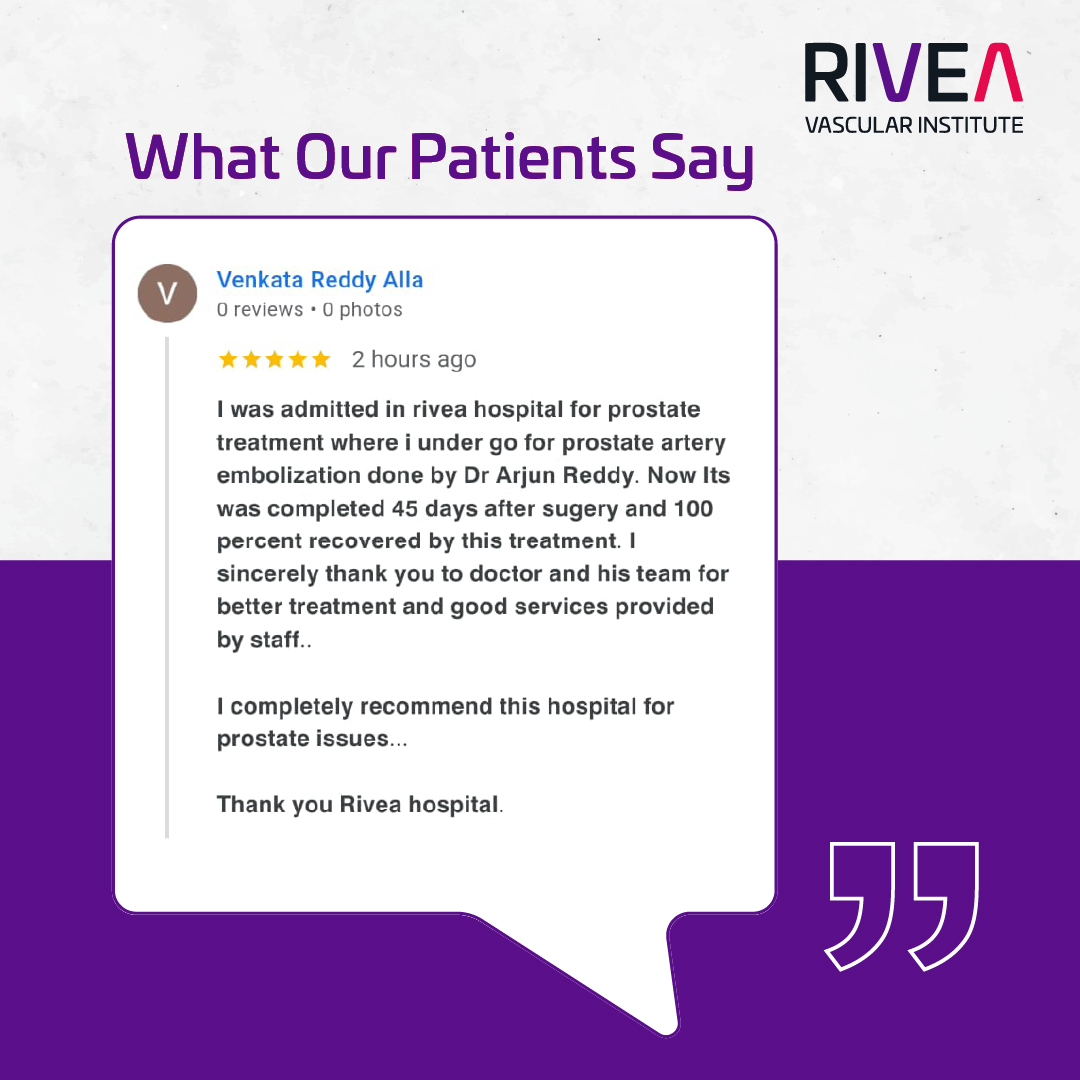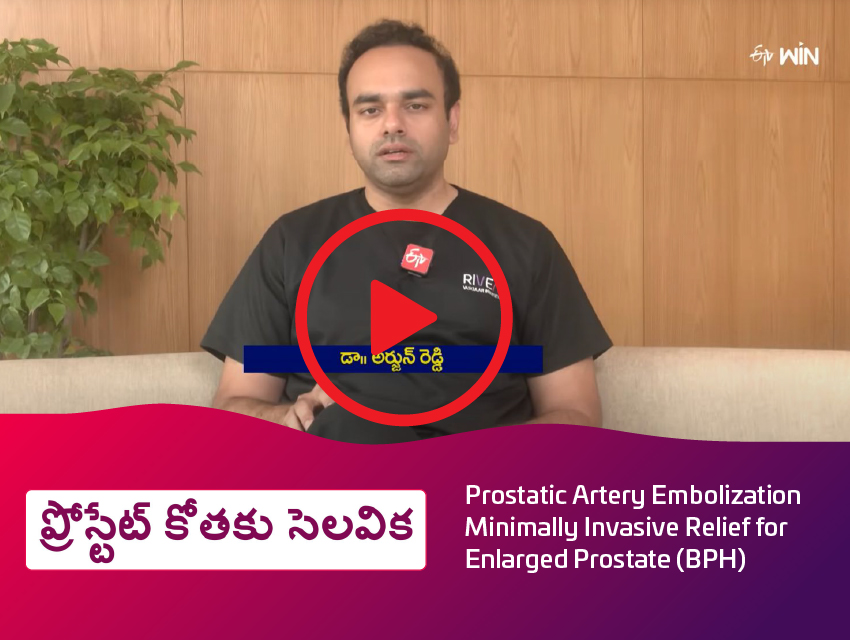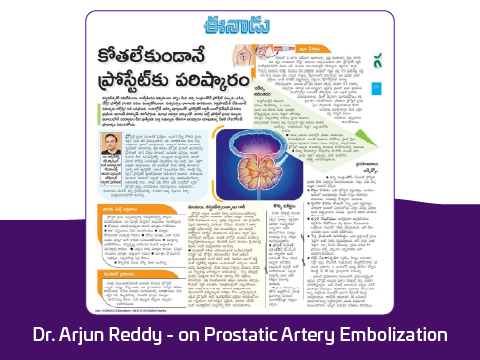Prostatic Artery Embolization (PAE)
As men age, changes in the prostate gland are common. For many over the age of 50, this includes Benign Prostatic Hyperplasia (BPH), a non-cancerous enlargement of the prostate that can press against the urethra and disrupt normal urinary function. Though not life-threatening, BPH can significantly affect quality of life with symptoms such as frequent urination, urgency, weak stream, or difficulty emptying the bladder.
For patients with BPH, RIVEA offers Prostatic Artery Embolization (PAE), a minimally invasive, image-guided treatment that provides symptom relief without surgery. The procedure is performed by Dr Arjun Reddy, one of South India’s leading interventional radiologists. PAE works by selectively reducing blood flow to the prostate, allowing it to shrink over time and relieve urinary obstruction.
Unlike traditional surgical approaches, PAE is typically done on an outpatient basis, does not require general anesthesia, and has a shorter recovery time. It is also associated with fewer side effects—particularly preserving sexual function—making it a compelling option for many patients.
RIVEA Vascular brings you Prostatic artery embolization treatment in Hyderabad, India, performed using advanced image-guided technology for precision and safety. Our expert interventional radiology team ensures that each patient receives personalized care, faster recovery, and lasting relief. If you are seeking a non-surgical, minimally invasive prostate treatment for your enlarged prostate, RIVEA is here to help you get back to living life fully.
When is PAE performed?
Prostatic Artery Embolization is a treatment specifically used to address symptomatic benign prostatic hyperplasia—a condition in which the prostate gland enlarges, compressing the urethra and disrupting normal urine flow. This can lead to symptoms such as:
- Frequent need to urinate, especially at night (nocturia)
- Difficulty starting urination
- A weak urine stream
- Feeling of incomplete bladder emptying
- Urinary urgency and leakage
While medications and surgery can help, not all men respond well to these treatments, and some may experience unpleasant side effects, particularly related to sexual function. PAE provides an excellent enlarged prostate treatment option that avoids many of the risks and recovery time associated with surgical procedures. Minimally invasive prostate treatment options like PAE offer a valuable alternative for those seeking relief without undergoing major surgery or enduring long-term medication regimens.
Understanding PAE
Who Is a Candidate for PAE?
Not everyone with BPH needs immediate treatment, but for those with moderate to severe symptoms that interfere with daily life, PAE can be an excellent option. Ideal candidates for PAE include:
- Men over 50 with enlarged prostates (>30 cc in volume)
- Those whose symptoms are not well-controlled by medications
- Men who prefer to avoid traditional surgery or are not surgical candidates
- Individuals without active urinary tract infections or prostate cancer
- Patients with normal or manageable kidney function and no allergy to contrast dye
A detailed evaluation, including physical exams, imaging tests (like MRI or ultrasound), and lab work, helps determine whether PAE is the right fit. An International Prostate Symptom Score (IPSS) higher than 15 is often used to assess the severity of symptoms.
What Happens During the Procedure?
Before the Procedure:
Before the procedure begins, you will typically undergo some evaluation. A complete pre-procedure evaluation may include:
- Digital Rectal Exam (DRE) to assess prostate size and rule out cancer
- Urinalysis to check for infections
- Prostate-Specific Antigen (PSA) Test to screen for prostate cancer
- Imaging tests such as ultrasound or MRI
- IPSS questionnaire to score the severity of symptoms
How Prostatic Artery Embolization (PAE) Is Performed
The PAE procedure is performed in a specialized radiology suite using real-time imaging guidance (like fluoroscopy) by an experienced prostate embolization doctor. Here’s what typically occurs:
- You’ll receive local anesthesia to numb the entry site— either the groin (femoral artery) or wrist (radial artery)—where the catheter will be inserted.
- General anesthesia is not required, meaning you’ll be awake but comfortable during the procedure. Sedation may be given to keep you relaxed.
- A small incision is made at the entry point.
- A tiny catheter is guided into the arteries that supply blood to the prostate using X-ray imaging.
- A contrast dye is injected through the catheter to map the exact location of these vessels.
- Once the prostatic arteries are identified, microscopic beads (embolic particles) are injected through the catheter to block the blood flow to the prostate. This is done on both sides of the gland.
- The catheter is removed, and a small bandage is applied. No stitches are needed.
Because the prostate’s blood supply is now reduced, the gland begins to shrink over the next several weeks, relieving the pressure on the urethra and improving urinary symptoms.
Procedure and Recovery
PAE typically takes 1.5 to 2 hours to complete. Since it is a minimally invasive prostate treatment, most patients are discharged the same day and can return to normal activities within a few days. Full relief of symptoms may take a few weeks to become noticeable as the prostate gradually shrinks.
Post-Procedure and Recovery:
Most men return to work within 2–5 days. However, following your PAE procedure, it’s important to follow these care guidelines to ensure a smooth and safe recovery:
- You may resume your normal diet immediately after the procedure.
- Drink plenty of fluids over the next 24 to 48 hours, unless your doctor has advised otherwise.
- Staying well-hydrated helps flush the contrast dye used during the procedure from your kidneys.
- Avoid alcoholic beverages for at least 24 hours post-procedure.
- Avoid strenuous activity, such as climbing multiple flights of stairs, for 24 hours.
- Do not lift heavy objects (more than 6–9 kilograms) for 7 days or until the puncture site is fully healed.
- Do not drive for at least 24 hours after the procedure.
- Keep the catheter site clean and dry for 5 days
Wound Care:
- Remove the bandage the day after the procedure.
- Clean the site gently with soap and water, then dry thoroughly.
- Apply a fresh adhesive bandage daily for 3 days.
- Do not use powders, creams, or lotions on the site for at least 5 days.
- Keep the area clean and dry to prevent infection.
Patients may notice continued improvement in urinary symptoms over a period of several weeks. Full benefits, including a 20–40% reduction in prostate size, are typically seen within 3–6 months.
Common Symptoms to Expect:
Some mild symptoms are normal during recovery and should resolve on their own:
- Increased frequency of urination, mild pressure in the lower abdomen, or slight burning when urinating (up to 7–14 days)
- Blood in the urine or semen (7–21 days)
- Mild discomfort, pressure, or urge to have a bowel movement while urinating
- A small amount of blood in the stool (4–7 days)
- Low-grade fever under 101.5°F (38.6°C) for a few days (up to 7 days)
- Bruising or tenderness around the puncture site, which may take up to 2–3 weeks to fully resolve
Contact your healthcare provider immediately if you experience any of the following:
- A fever above 101.5°F (38.6°C)
- Inability to urinate
- Symptoms that do not improve with prescribed medications
- A growing lump or one that pulses at the catheter insertion site
- Signs of infection such as redness, warmth, drainage, or increased pain at the puncture site
What are the risks of PAE?
As with all medical procedures, PAE carries some risks. Although it is generally very safe, it should only be performed by an experienced interventional radiologist. Compared to surgery, PAE offers a significantly lower risk of urinary incontinence and sexual side effects, such as erectile dysfunction or retrograde ejaculation.
While serious complications are uncommon, some side effects may occur, such as:
- Hematoma (bruising or bleeding) at the catheter insertion site (groin or wrist)
- Blood in the urine, semen, or stool for a short duration
- Bladder spasms or irritation
- Infection at the puncture site or within the prostate (managed effectively with antibiotics)
Rare Complications
- Urinary tract infections (UTIs) occur in approximately 3–5% of patients. These are typically mild and treatable with antibiotics.
- Penile ulceration is a very rare complication affecting fewer than 1 in 200 patients. These ulcers are temporary, typically healing within 2–3 weeks and can be managed with topical treatments and pain relief without causing permanent damage.
Why choose PAE?
Outpatient procedure. You can go home the same day
No general anesthesia, no surgical cuts
Low risk of side effects like incontinence or sexual dysfunction
Quick recovery
Long-lasting symptom relief
If you are looking for a non-surgical treatment for BPH, RIVEA offers minimally invasive care that helps reduce symptoms and improve your quality of life.
Why choose RIVEA for PAE?
RIVEA Vascular Institute aims to become one of the top centres for Prostate Artery Embolization (PAE) in Hyderabad, India. We specialize in advanced, minimally invasive vascular procedures with a strong focus on patient comfort, faster recovery, and lasting relief.
Leading our team is Dr. Arjun Reddy, Co-founder of RIVEA, recognized as one of the Best Interventional Radiologists in Hyderabad. He is a leading specialist in PAE and other minimally invasive procedures, with extensive experience at premier hospitals. He performed Hyderabad’s first PAE at AIG Hospitals with outstanding results, a milestone that positioned him as a leading expert in the field. Dr. Reddy is widely respected for delivering world-class outcomes with a compassionate, patient-first approach.
At RIVEA, we combine cutting-edge technology, global expertise, and personalized care to ensure the safest and most effective solutions for vascular conditions. We are quickly becoming one of the top centres for BPH treatment in Hyderabad, offering state-of-the-art imaging, expert interventional radiologists, and personalized patient service. If you’re considering prostate artery embolization in Hyderabad, choose RIVEA for trusted expertise and exceptional care.
What RIVEA offers:
Allia IGS 7 hybrid imaging system for ultra-precise minimally invasive procedures
Patient-first approach focused on comfort and fast recovery
One-on-one guidance from diagnosis through follow-up
Opt for PAE to treat enlarged prostate without surgery in Hyderabad, India at RIVEA Vascular and experience advanced, image-guided care that ensures precision, comfort, and faster recovery — helping you regain normal urinary function and quality of life.
Meet your doctor
Dr. Arjun Reddy MBBS, MD, FVIR
Dr. Arjun Reddy made history as the first physician to perform PAE in Hyderabad. Under his leadership, RIVEA's interventional radiology team delivers exceptional outcomes for BPH patients seeking minimally invasive treatment options performed by experts who have mastered this sophisticated technique.
With specialized training in the U.S. and extensive experience performing complex embolization techniques, Dr. Reddy brings precision, safety, and a patient-first approach to every treatment. His dedication to innovation and compassionate care ensures that patients at RIVEA receive the best that modern medicine has to offer.

Dr. Arjun Reddy
MBBS, MD
Chief Interventional Radiologist
FAQs
Does an enlarged prostate mean I have cancer?
No. BPH is not prostate cancer and does not increase your risk of developing it. However, it's important to have a proper diagnosis to rule out cancer and confirm that your symptoms are due to BPH.
How does PAE compare with other treatments like TURP?
Here’s how Prostate Artery Embolization (PAE) stacks up against common surgical treatments like Laser TURP and Traditional TURP:
Prostate Artery Embolization (PAE)
- Non-surgical procedure
- Minimally invasive
- Outpatient procedure
- No scars or stitches
- Quick recovery — usually 1–2 days
- Performed by an Interventional Radiologist
Laser TURP
- Surgical procedure
- Minimally invasive
- Requires 1–2 days of hospital stay
- Minimal scars/stitches
- Recovery time — about 1 week
- Performed by a Urologist
Traditional TURP
- Surgical and more invasive
- Requires 3–4 days of hospital stay
- Minimal scars/stitches
- Recovery time — typically 1–2 weeks
- Performed by a Urologist
Each has its pros and cons. PAE is often chosen by men who want relief without surgery, cuts, or prolonged recovery.
Who Can Benefit from PAE?
PAE is ideal for men:
- With moderate to severe urinary symptoms due to BPH
- Who are not candidates for surgery due to other health issues
- Who want to avoid surgical risks or preserve sexual function
- Looking for a quick recovery and minimal downtime
Who performs the PAE procedure?
PAE is performed by a specialized Interventional Radiologist—a doctor trained in using imaging technology to perform targeted, minimally invasive procedures.
Is PAE painful?
PAE involves minimal discomfort. It’s done under local anesthesia with mild sedation. Some patients may experience slight pelvic cramping, but it's temporary and manageable.
How long does the procedure take?
Typically, the procedure takes 1.5 to 2 hours, followed by a brief recovery period. Patients usually go home the same day.
How soon will I feel better?
Most men notice improvement in urinary symptoms within 2 to 6 weeks, with continued relief over the following months.
Is PAE safe?
Yes. PAE is considered very safe, especially compared to traditional surgery. It has a low risk of side effects, preserves sexual function, and avoids general anesthesia.
Will it affect my sexual function?
Sexual function is typically preserved after PAE. In fact, some men report improvement in sexual well-being as their urinary symptoms improve.
Are the results permanent?
PAE offers long-term relief, though in some cases, symptoms may return over the years. If needed, the procedure can be repeated.
Get Support & Information
Click here to learn more about:
Benign Prostatic Hyperplasia (BPH)
For any inquiries, post your query here:
Ask Rivea
Contact us today to explore your options.
Call Now

Our Team
-

Dr. Arjun Reddy
MBBS, MD
Chief Interventional RadiologistDr. Arjun Reddy is a highly accomplished Interventional Radiologist with extensive international training and a track record of pioneering minimally invasive, image-guided procedures in India.
View Profile Book an Appointment
Have more questions?
Book a consultation at RIVEA Vascular Institute, Hyderabad





